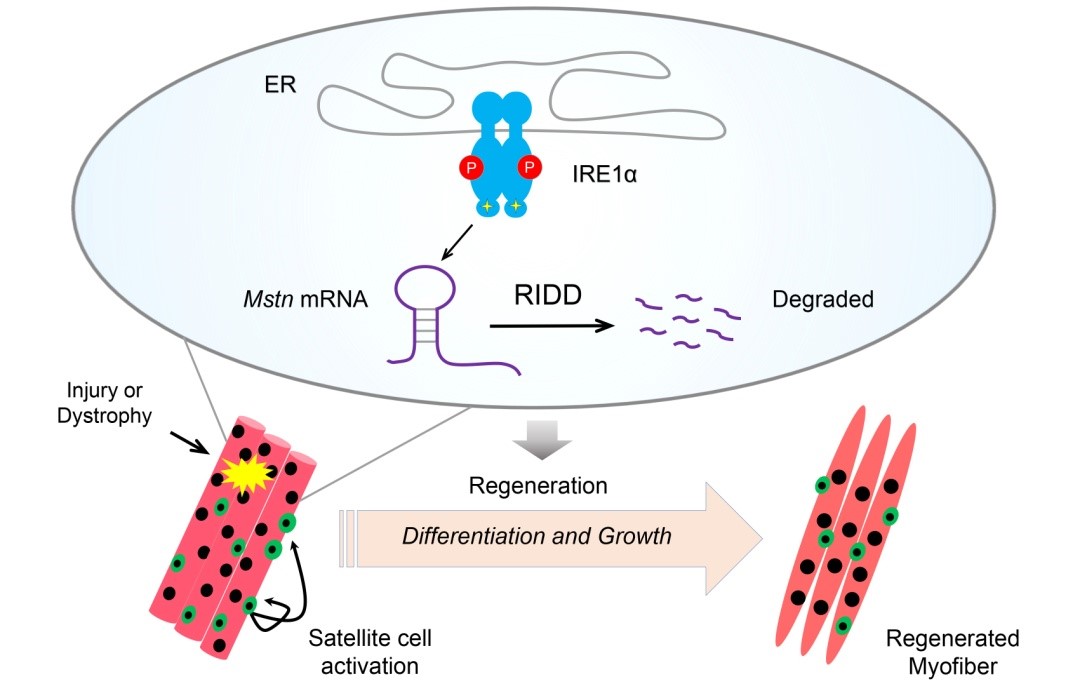2021年9月2日,国际著名医学期刊Journal of Clinical Investigation(影响因子14.8)在线发表了武汉大学生命科学学院刘勇课题组题为“IRE1α regulates skeletal muscle regeneration through Myostatin mRNA decay”的合作研究成果。此项工作揭示了骨骼肌中内质网应激感应蛋白IRE1α通过调控肌肉生长抑制素(Myostatin)的mRNA 降解影响骨骼肌再生过程,在肌肉损伤修复与肌萎缩疾病的发生发展中发挥重要的作用。
在真核细胞中,当内质网难以承担未折叠蛋白负荷或代谢发生异常时会导致内质网应激,激活三条经典的未折叠蛋白响应(UPR,Unfolded Protein Response)通路,其中包括进化上高度保守的内质网应激感应蛋白IRE1通路。IRE1α是定位于内质网的跨膜蛋白,具有蛋白激酶与核酸内切酶的双重活性,激活的IRE1核酸内切酶通过催化XBP1转录因子mRNA的非常规剪接产生具备转录活性的 XBP1 (XBP1s),从而驱动一个主要的UPR基因表达程序。同时,IRE1核酸内切酶还能通过一个被称为RIDD(regulated IRE1-dependent decay)的过程直接降解特定的mRNA底物,从而参与细胞生存与功能的调控。在哺乳动物中,IRE1α信号通路涉及调节广泛的生物学过程,包括细胞命运决定、代谢稳态和免疫反应。
为了解析IRE1α通路与骨骼肌功能调节之间的机制关联,通过心脏毒素(CTX)诱导的小鼠急性肌肉损伤模型研究发现,IRE1α在损伤诱导的肌肉再生过程中高度激活,而在骨骼肌特异性敲除IRE1α的小鼠中,心脏毒素诱导的肌肉再生显著受损。利用小鼠及肌细胞培养系统的研究显示,IRE1α通过抑制肌肉生长和修复的关键负调节因子—肌肉生长抑制素Myostatin,从而发挥骨骼肌再生的调控作用。进一步的分子机制研究发现,在肌肉细胞分化和生长过程中,IRE1α利用其核酸内切酶的RIDD活性降解肌肉生长抑制素的mRNA。简言之,在肌肉损伤诱导的再生过程中,肌肉细胞被激活的IRE1α核酸内切酶通过调节肌肉生长抑制素,进而促进成肌细胞分化和肌管生长。此外,IRE1α这一通过RIDD活性的调节机制与肌萎缩疾病进展密切相关。在Duchenne肌肉萎缩症(DMD)的疾病小鼠模型中,肌肉IRE1α的缺失导致肌肉生长抑制素信号增强,进而促进肌肉损伤症状的恶化,加剧了小鼠运动障碍的表型。
综上所述,此项研究揭示了IRE1α在肌肉再生过程中的关键作用,并阐明了IRE1α-Myostatin信号轴在肌肉细胞分化和再生过程中的调控模式,为治疗肌肉退行性疾病的药物研发提供了新的潜在靶点和理论线索。
该项研究由武汉大学刘勇课题组和南京大学甘振继课题组共同合作完成,并得到科技部重点研发计划、国家自然科学基金委重大项目等基金的资助支持。武汉大学博士后何胜琪为该论文的第一作者。

IRE1α通过RIDD通路抑制肌肉生长抑制素促进骨骼肌的再生修复。
在线网址:https://www.jci.org/articles/view/143737/
Skeletal muscle can undergo a regenerative process from injury or disease to preserve muscle mass and function, which are critically influenced by cellular stress responses. Inositol-requiring enzyme 1 (IRE1) is an ancient endoplasmic reticulum (ER) stress sensor and mediates a key branch of the unfolded protein response (UPR). In mammals, IRE1α is implicated in the homeostatic control of stress responses during tissue injury and regeneration. However, it has yet to be explored whether IRE1α plays a role in sensing skeletal muscle stress and regulating its regeneration process. A joint research team led by Dr. Yong Liu from Wuhan University and Dr Zhenji Gan from Model Animal Research Center of Nanjing University, demonstrated a critical role for IRE1α, the ER-localized transmembrane UPR signal transducer, in skeletal muscle regeneration in response to injury and muscular dystrophy. In a Research Article entitled “IRE1α regulates skeletal muscle regeneration through Myostatin mRNA decay” at Journal of Clinical Investigation, they reported in mice that IRE1α was activated during injury-induced muscle regeneration, and muscle-specific IRE1α ablation resulted in impaired regeneration upon cardiotoxin-induced injury. Gain- and loss-of-function studies in myocytes demonstrated that IRE1α acts to sustain both differentiation in myoblasts and hypertrophy in myotubes through regulated IRE1-dependent decay (RIDD) of mRNA encoding Myostatin, a key negative regulator of muscle repair and growth. Furthermore, in the mouse model of Duchenne muscular dystrophy (DMD), they showed that loss of muscle IRE1α resulted in augmented Myostatin signaling and exacerbated the dystrophic phenotypes. Their findings revealed a pivotal role for the RIDD output of IRE1α in muscle regeneration, offering novel insight into potential therapeutic strategies for muscle loss diseases.